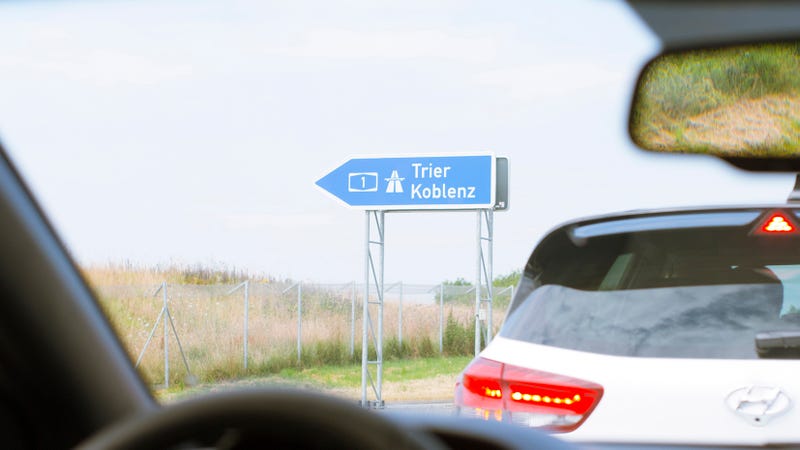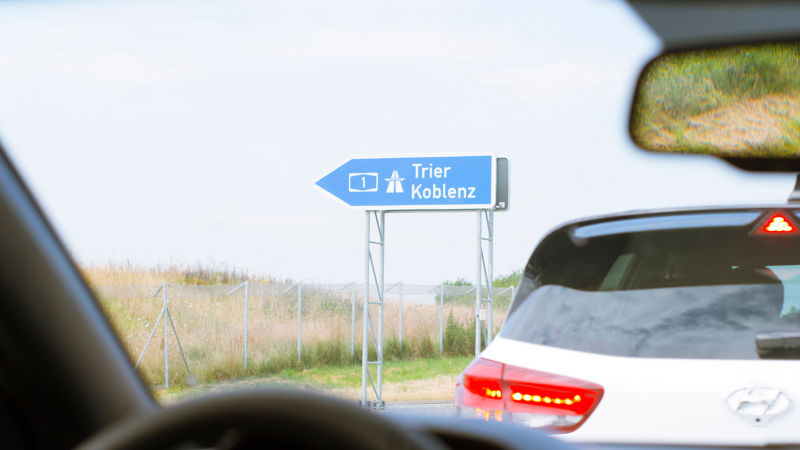
The digital speedo clicked up from 265 to 266 kilometers per hour, a good 165 mph. It was safe as can be and completely legal, because we were on a de-restricted section of the Autobahn that is, quizzically, a dead end.
Where It’s At
You’re on the A1, the Eifelautobahn. You get to it by turning off of road 410 outside of Kelberg. It’s only a short drive from the Nürburgring Nordschleife, which is about an hour and a half west of Frankfurt. Over here you’re in one of the prettiest parts of Germany, out away from the interchangeable mid-size cities that are all the same uniform beige-grey and all the bakeries look oddly corporate. Well, that’s not fair. Pretty much all the bakeries in Germany outside of random hipster city centers look oddly corporate. I’m getting away from the point.
Advertisement
In any case, the area around the Ring isn’t exactly what you’d call “centrally located.” It’s a bit out there, pretty much all ag land in between the volcanic hills and little villages. The big ones have about 2 or 3 thousand residents, the little ones are what we’d in America recognize more as a sub-development than a town.
This is to say that there isn’t a ton of traffic, and everyone is pretty safe and respectful. I’m talking about the area around the Ring, not the direct roads that abut it itself. That’s where you find people heel-toe downshifting their Ariel Atom at every intersection and periodically crashing their strangely road-legal Ferrari 458 Challenge car. Not that that happened this week. Not that I saw that Instagram Story.
What To Drive
Advertisement
Bring something stable. This is a typically well-maintained and relatively new section of German highway, so it feels like glass compared to, say, the Cross-Bronx. But there are long sweeping curves and there are expansion joints as you’re very high off the ground, cutting from one hilltop to another. Hyundai flew me out to the Ring to drive the new Veloster N that had 275 horsepower (fun!) and adjustable suspension (stiff and bouncy but not sketchy), which worked well.
Highlights
Importantly, the road is under construction and has been for decades, lost in an endless series of changes that hang on environmental concerns, as this local paper timeline neatly explains. As such, this section of this de-restricted highway is a dead end.
Advertisement
It goes up to 410. It goes down from 410. What it does not do is go from 410 up to connect with the rest of the A1. This missing section is called the A1 Lückenschluss, which directly translates to “English speaking world please do not look at this part because Germany is perfect and we never get anything wrong least of all Autobahns please look away, again, look away it’s fine.”
I crudely highlighted how the A1 goes down above this area and the up towards it, but not through it here:
Advertisement
Do not forget: the A1 is a big as hell highway, running from basically the top of Germany at Puttgarden all the way down to Saarbrücken, the city in which I first discovered the joy of Germany’s lack of open-container laws. This map should show how the route is meant to go across much of the western side of Germany:
At some point it will all be connected and it will be busy like any other big, German de-restricted Autobahn. But at the moment it doesn’t perfectly link anything together, so it’s just, like, a local highway.
Advertisement
Again, a dead-end, de-restricted Autobahn.
Hazards
Just because Germany has a reputation for extremely attentive drivers, they’re not actually superhuman. Van drivers will wander into the left lane. Be very, very, very aware and maintain strict keep-right-except-for-passing discipline when you’re not going flat out.
Advertisement
If You Go
I don’t think there’s a faster place in the world, legally at least. Soar above the fields, out there. Go as fast as you dare. Bounce across the expansion joints at a buck forty, a buck fifty, whatever. Just don’t crash.
 Jalopnik ReviewsAll of our test drives in one convenient place.
Jalopnik ReviewsAll of our test drives in one convenient place.












